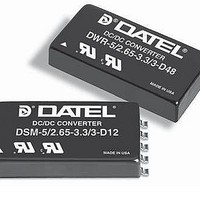DWR-5/2.65-3.3/3-D48-C Murata Power Solutions Inc, DWR-5/2.65-3.3/3-D48-C Datasheet - Page 5

DWR-5/2.65-3.3/3-D48-C
Manufacturer Part Number
DWR-5/2.65-3.3/3-D48-C
Description
DC/DC TH 15W 48-5/3.3V Dual XWR
Manufacturer
Murata Power Solutions Inc
Series
DWRr
Datasheet
1.DSM-52.65-3.33-D12-C.pdf
(9 pages)
Specifications of DWR-5/2.65-3.3/3-D48-C
Product
Isolated
Output Power
13 W
Input Voltage Range
36 V to 75 V
Input Voltage (nominal)
48 V
Number Of Outputs
2
Output Voltage (channel 1)
5 V
Output Current (channel 1)
2.65 A
Output Voltage (channel 2)
3.3 V
Output Current (channel 2)
3 A
Isolation Voltage
1.5 KV
Lead Free Status / Rohs Status
Lead free / RoHS Compliant
5V & 3.3V Regulation
The XWR Series converters are designed such that both the 5V and 3.3V out-
puts share a common regulation feedback control loop. Though the feedback
loop is infl uenced by both outputs, the 3.3 Volt output is dominant. As a result,
the 3.3 Volt regulation (0.5%) is superior to the 5 Volt regulation (1.5%).
The converters are specifi ed for load regulation of minimum (250mA) to 100%
loading. All models are stable under no-load conditions, but operation below
minimum load mandates an increase in the regulation tolerance of ±0.5% for
3.3 Volt output and an increase of ±1% for the 5 Volt output. A slight increase
in switching noise may also be observed for operation below minimum load-
ing. Operation with a full load on 3.3 Volt output and light to no load on 5 Volt
output is the most demanding for +5V regulation.
Filtering and Noise Reduction
The XWR Series Converters achieve their rated ripple and noise specifi ca-
tions with the use of 0.47µF ceramic in parallel with 100µF tantalum output
capacitors. In critical applications, input/output noise may be further reduced
by installing additional external I/O capacitors. Input capacitors should be
selected for bulk capacitance, low ESR and high rms-ripple-current ratings.
Output capacitors should be selected for low ESR and appropriate frequency
response. All caps should have appropriate voltage ratings and be located as
close to the converter as possible.
Thermal Shutdown
These XWR converters are equipped with Thermal Shutdown Circuitry. If
the internal temperature of the DC/DC converter rises above the designed
operating temperature, a precision temperature sensor will power down the
unit. When the internal temperature decreases below the threshold of the
temperature sensor, the units will self start.
Current Limiting
When power demands from either output fall within 120% to 190% of the
rated output current, the DC/DC converter will go into a current limiting mode.
In this condition, both output voltages will decrease proportionately with
increases in output current, thereby maintaining a somewhat constant power
dissipation.
This is commonly referred to as power limiting. Current limit inception is
defi ned as the point where the full-power output voltage falls below the
specifi ed tolerance. If the load current being drawn from the converter is
signifi cant enough, the unit will go into a short circuit condition. See “Short
Circuit Condition.”
Short Circuit Condition
When a converter is in current limit mode the output voltages will drop as
the output current demand increases. If the output voltage drops too low, the
magnetically coupled voltage used to develop primary side voltages will also
drop, thereby shutting down the PWM controller.
Following a time-out period of 5 to 15 milliseconds, the PWM will restart,
causing the output voltages to begin ramping to their appropriate values. If
the short-circuit condition persists, another shutdown cycle will be initi-
ated. This on/off cycling is referred to as “hiccup” mode. The hiccup cycling
reduces the average output current, thereby preventing internal temperatures
from rising to excessive levels. The modules are capable of enduring an
indefi nite short circuit output condition.
www.murata-ps.com
Trimming Output Voltages
The DSM/DWR converters have a trim capability (pin 9) that allow users
to adjust the output voltages ±5%. A trim adjustment will cause an equal
percentage of change in both outputs. Adjustments to the output voltages can
be accomplished via a trim pot, Figure 3, or a single fi xed resistor as shown
in Figures 4 and 5. A single fi xed resistor can increase or decrease the output
voltage depending on its connection. Fixed resistors should have absolute TCR's
less than 100ppm/°C to minimize sensitivity to changes in temperature.
A single resistor connected from the Trim pin (pin 9) to the +3.3V Output (pin 8),
see Figure 4, will decrease the output voltages. A resistor connected from the
Trim pin (pin 9) to Output Return (pin 7) will increase the output voltages.
Trim adjustments greater than 5% can have an adverse effect on the con-
verter's performance and is not recommended.
Accuracy of adjustment is subject to tolerances or resistor values and factory-
adjusted output accuracy. V
Dual Output, 3.3V and 5V, 15Watt DC/DC Converters
2
3
4
2
3
4
1
1
Figure 4. Decrease Output Voltage Trim Connections
+INPUT
+INPUT
–INPUT
ON/OFF
CONTROL
CASE
–INPUT
ON/OFF
CONTROL
CASE
2
3
4
1
Figure 5. Increase Output Voltage Trim Connections
Figure 3. Trim Connections Using A Trimpot
Technical enquiries email: sales@murata-ps.com, tel:
+INPUT
–INPUT
ON/OFF
CONTROL
CASE
R
T
DOWN
R
T
(kΩ) =
+3.3V OUTPUT
+3.3V OUTPUT
Using A Fixed Resistor
UP
O
+5V OUTPUT
+5V OUTPUT
(kΩ) =
= desired output voltage.
Using A Fixed Resistor
DSM/DWR Models
OUTPUT
RETURN
OUTPUT
RETURN
+3.3V OUTPUT
+5V OUTPUT
2.49(V
TRIM
TRIM
3.3 – V
V
OUTPUT
RETURN
3.073
O
MDC_DSM/DWR Models.B01 Page 5 of 9
O
TRIM
– 3.3
5
8
9
5
8
9
7
7
– 1.234)
O
R TRIM
DOWN
8
5
7
9
–14
20kΩ
5-22
Turns
–14
+3.3V LOAD
+5V LOAD
R TRIM
+5V LOAD
+3.3V LOAD
+3.3V LOAD
+5V LOAD
UP
+1 508 339 3000


















